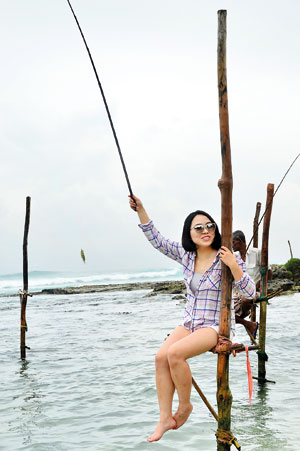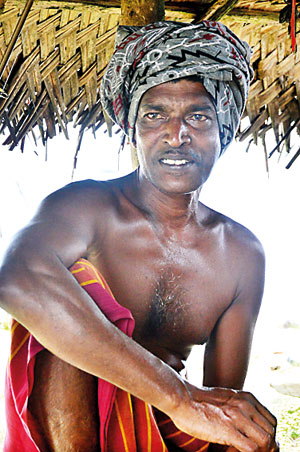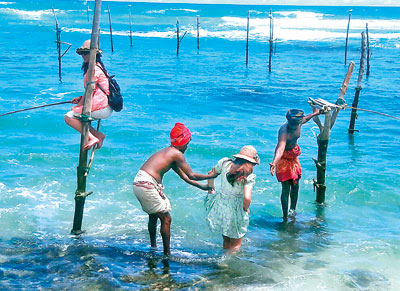Drowning tradition gets a step up

Trying it out: A Chinese tourist on stilts
Stilt fishing is very famous in Sri Lanka – everyone knows about it but very few actually practise it. Today this unique livelihood, which has been passed down from father to son for many generations, is on the decline. Modern fishing techniques, marine pollution and the inherently difficult nature of the profession have all played their part in making scarce a practice once common on the Southern coast.
However, a revival of the industry has been taking place recently: Don’t be surprised if instead of a lean and sunburnt fisherman perched on the stilt, you glimpse a young woman in a wide-brimmed hat, skirts billowing in the breeze. Tourists are now being offered a chance to try their hand at stilt fishing.
Fishermen who would otherwise find it difficult to make ends meet are now teaching tourists how it’s done. This new concept has become so popular that leading tour operators such as Hemas Travels, Royal Holidays and Gabo Travels offer this experience through the local hotels who organise the excursion or direct through the fishermen themselves.
It’s a far cry from when one would drive down the coast hoping for a glimpse of the stilt fishermen. Now the tour guide calls one of the fishermen ahead so that he can inform the others to get ready. The fishermen climb onto their poles and begin fishing, waiting for the tour bus to arrive. On arrival, the tourists take the opportunity to pose for pictures with the fishermen and even get on the stilts themselves. The whole experience could take anywhere from ten minutes to an hour.
Payment varies – tourists are usually charged Rs. 200 for taking pictures and Rs. 500 – 1000 to climb a stilt. Some fishermen even offer tour companies a flat rate of around Rs. 2500 for any number of tourists to photograph them. Sometimes there are tips from the satisfied tourists.
Most of the visitors trying out the stilt fishing are Chinese, the fishermen say. They arrive from around 9 a.m. to 12 noon and then from 2 p.m. to 4 p.m. These times are convenient for the stilt fishermen because they usually fish from 6 a.m. to 9 a.m. and again in the evening, allowing them time in between to interact with the tourists.
We meet Sanjeeva, a Chinese –speaking tour guide with the Deluxe Vacations travel group, in Marandawala, Habaraduwa, one of the most popular stilt fishing spots. Sanjeeva, believes that the reason this particular spot is so popular is because of the positive attitude of the fishermen who live there. Three brothers and their friends occupy this spot. Ramyasiri, 53, says that this is the best way to earn a good income. “We used to be able to earn a good living by fishing alone. But now, there are many things which prevent us from doing so. One of the biggest issues we face is environmental pollution. Because of all this, our livelihood has declined so we engage in activities like this to help us make ends meet,” he says.

After losing everything to the tsunami in 2004, Ramyasiri and his friends have had a difficult time rebuilding. They charge Rs. 500 to any tourist looking to climb on the stilts – less than the usual price of Rs. 1000 in other places. He says on a good day they would get up to 20 tourists looking to do so.
Life is hard nevertheless. “We have people coming and talking to us all the time, asking us questions and sometimes even making promises. We have had journalists, students and even politicians come and visit us but we never really see the benefits of such visits,” he says but feels that it’s his duty to educate people on this dying trade.
Most of the fishermen though are averse to speaking to the press as they felt that the publicity has done them more harm than good. One was vocal about the big hotels polluting the seas, but insisted on remaining anonymous.
For the tourists, it was, no doubt, a novel experience. Xixi, on her first visit to Sri Lanka from China, was game to try stilt fishing. “You can really see the experiences of the fishermen when you try it out for yourself and it’s very good,” she says of her experience. Chris Kirchkoff from Germany, agreed. He says he’s happy to try something which he had only seen before in pictures. Dong Min, who is also from China, was wary of taking part in the fishing because he felt it looked dangerous even though it was interesting. His fellow tourist Shi Ming Jie clearly disagreed because she felt that if she could get on a stilt at 64, then so could anyone else.
So what does this new partnership mean for the fishermen? Jayasiri, who coordinates the experience, feels that it’s a way for fishermen such as him to make ends meet. “It’s becoming more and more difficult for us to make ends meet and this gives us a way to feed our children,” he says. What may look like easy money at first glance is actually quite a difficult lifestyle – they are usually at the beach from around 6 a.m. until 7 or 8 p.m. Lunch is brought to them and they stay on the beach throughout, in spite of living just across the road.
Stilt fishermen are offered no support from the government and at the end of the day, letting tourists climb their stilts seems a minor concession to help them survive, they feel.
“You will see us all across the island, and everyone knows who stilt fishermen are – even in Jaffna you can see us in paintings, but no one stops to think of what our lives are like or helps us. So we must help ourselves,” Jayasiri says.

Ramyasiri

Getting to their perch with a little bit of help from local fishermen. Pix by Indika Handuwala and Krishan Jeewaka Jayaruk


